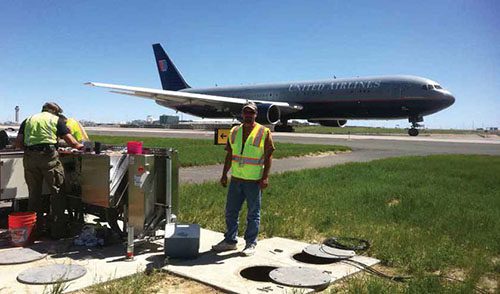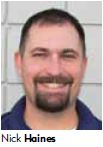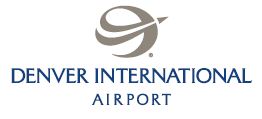 Before a $6.64 million airfield lighting project was completed at Denver International (DEN) last spring, the airport's surface movement guidance and control system (SMGCS) needed a major upgrade. The system, which was installed in the 1990s, included stop bar lights at runway entrances for all six runways but no in-pavement runway guard lights. In addition, its multimode fiber optic cable was old and some of the connectors were starting to break off, explains DEN's Electrical Support Engineer Heather McKee.
Before a $6.64 million airfield lighting project was completed at Denver International (DEN) last spring, the airport's surface movement guidance and control system (SMGCS) needed a major upgrade. The system, which was installed in the 1990s, included stop bar lights at runway entrances for all six runways but no in-pavement runway guard lights. In addition, its multimode fiber optic cable was old and some of the connectors were starting to break off, explains DEN's Electrical Support Engineer Heather McKee.
"We were looking for ways to improve safety and prevent runway incursions," McKee explains.
"Under our old system, we had the possibility of aircraft or vehicles entering a runway thinking they were on a taxiway."
The scale of the 21/2-year project was "immense," reflects Mike Southwick, airfield electrical engineer for designer of record CH2M Hill. "It's not too often that you get to replace an entire lighting control system for an airport with six runways and a network of taxiways while ensuring that the airport remains up and running," notes Southwick.
Reliability Infusion
The project began when crews replaced the multimode fiber optic cable that encircled the airfield with approximately 40 miles of faster, more reliable single-mode optic cable. A self-healing ring was also installed.
|
Project: Airport Lighting Computer & Monitoring System; Surface Movement Guidance & Control System Location: Denver Int'l Airport Cost: $6.64 million Funding: Airport Improvement Program (60%); Capital Improvement Projects (40%) Timeline: 21/2 yrs.
Project Management: City & County of Denver; Denver Int'l Airport Of Note: New lighting system was installed parallel to existing system to minimize airfield disruptions. |
The new cable links three critical elements to DEN's centrally located air traffic control tower:
• three airfield lighting vaults
• 18 circuit selector switch cabinet racks
• various maintenance and monitoring sites
Two selector switch racks and associated inductive loops were installed to allow takeoffs on the two east-west runways during the SMGCS project.
Crews also replaced existing inset stop bar lights with dual stop bar/runway guard lights. The existing circuit selector switch racks could not be used because the conduit space available for circuiting was limited within the full-strength pavement. Addressable power line carrier modules were the only option for operating the inset runway guard lights during non-SMGCS conditions and the stop bar lights during the SMGCS project.
"If the cable is damaged anywhere along the ring, information is back fed so data is not lost and the system remains viable," explains Alan Perry, electrical consultant to prime contractor Tetra Tech.
 "Installing the new cable also allowed the airport to add SMGCS routes while improving fiber optic connectivity. It increases the reliability of the entire system."
"Installing the new cable also allowed the airport to add SMGCS routes while improving fiber optic connectivity. It increases the reliability of the entire system."
Tetra Tech Construction Services installed 1,000 in-pavement runway guard light/stop bar fixtures. ADB Airfield Solutions installed the SMGCS control and Gen IV airport lighting computer and monitoring system (ALCMS) as its subcontractor. Fourteen new computers with redundant functionality were placed in the air traffic control tower, electrical vaults and several maintenance facilities around the airport. Eight BRITE(tm) Masters and 1,074 BRITE(tm) Remotes, ADB's trademark name for its power line communication system, were also installed. The additional BRITE remotes control existing elevated stop bar lights. The new ALCMS controls 152 constant current regulators in three lighting vaults as well as the tower, maintenance and deicing station nodes. The constant current regulators are the power source for DEN's airfield lighting.
 "The maintenance node monitors not only the lighting control system, but all control systems around the airport," reports ADB Project Manager Nick Haines. "The airport is able to dispatch staff based on which system needs attention and who needs to be involved. There is also a touch screen control system at the deicing facility, which allows them to control the deicing lanes. The air traffic control tower has four touch screens controlled by four computers with full redundancy located in another room at the airport."
"The maintenance node monitors not only the lighting control system, but all control systems around the airport," reports ADB Project Manager Nick Haines. "The airport is able to dispatch staff based on which system needs attention and who needs to be involved. There is also a touch screen control system at the deicing facility, which allows them to control the deicing lanes. The air traffic control tower has four touch screens controlled by four computers with full redundancy located in another room at the airport."
ADB also installed its Virtual Vault(tm), which provides graphical representations of the electrical vaults' interiors. If an alarm sounds, maintenance personnel see the problem area on the screen. A communications page allows the maintenance staff to see all of the communication links and their operational status. New network switches were installed as well.
Each constant current regulator received a distributed control and monitoring device that receives commands from the computer, interprets them, and then turns them on/off and changes the intensity. The devices also monitor current and voltage and have a built-in system to monitor the insulation resistance of the field circuits. This helps maintenance staff members identify bad sections of cable because they can see whether a circuit is degrading and anticipate needed replacements.
Comprehensive Overhaul
The airfield lighting project proved to be more complex and challenging than originally expected, notes DEN Project Manager Paul Pfeiffer.
"We knew it was going to be tough to get in and get everything done, but I don't think anyone realized it was going to be as difficult as it was," Pfeiffer reflects. "The biggest issue was coordinating closures and making multiple trips into various areas on the airfield."
Limited work hours, some during the day but most at night, meant work was completed on a piecemeal basis, he explains. Weekly meetings with the contractor, subcontractors, suppliers, operations staff and maintenance personnel were held to "keep everyone working off the same page."
 The airport's intranet system proved especially helpful managing various request forms, McKee notes. "It took a lot of coordination," she elaborates. "What with the runway, power and fire alarm shutdown requests, we used to have to track people down in their office or on the phone, get a signature and then run around for more signatures. With the intranet, all the forms go automatically to the right people and you get a response back quickly."
The airport's intranet system proved especially helpful managing various request forms, McKee notes. "It took a lot of coordination," she elaborates. "What with the runway, power and fire alarm shutdown requests, we used to have to track people down in their office or on the phone, get a signature and then run around for more signatures. With the intranet, all the forms go automatically to the right people and you get a response back quickly."
The new lighting system was installed parallel to the existing system in order to keep the existing system up and running while the work was in progress. The changeover to the new system, however, was described as "tricky."
A lot of thought went into phasing the weeklong switchover in April 2011, recalls Jackie Meyer, project inspector for AECOM. "We kept the computers of the two systems running side by side while we did the swap," Meyer explains. "Out in the field, we had to go into every circuit selector switch rack and bypass the switches for the stop bar circuits in order to put each complex onto one complete circuit. With the old system, every stop bar was individually controlled by a switch. We had to pull all the circuits off of their individual switches, tie them together, and then calibrate and adjust their frequency. It took a lot of coordination between the tower and operations, but everyone worked hand in hand to complete the project successfully."
The biggest concern, Haines reflects, was determining how to take the old system offline and bring the new system online quickly and efficiently. "Overall," he says, "the plan went smoothly and we were able to minimize downtime for air traffic control."
Documenting the cutover plan and obtaining input from operations, the contractor and air traffic control was key, he adds. "At the end of the day, everybody agreed how we were going to do it, and we did it successfully," concludes Haines.

 factsfigures
factsfigures
